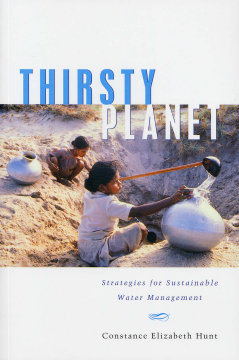
Additional Information
Book Details
Abstract
By the year 2025 nearly 2 billion people will live in regions experiencing absolute water scarcity. In the face of this emerging crisis, how should the planet's water be used and managed? Current international policy sees nature competing with human uses of water. Hunt takes issue with this perspective. She suggests that nature is the source of water and only by making the conservation of nature an absolute priority will we have the water we need for human use in future. It is essential , therefore, to manage water in ways that maintain the water cycle and the ecosystems that support it.
This book looks at the complexity of the problem. It provides a wide array of ideas, information, case studies and ecological knowledge - often from remote corners of the developing world -- that could provide an alternative vision for water use and management at this critical time.
Essential and compelling reading for students on courses related to water resource management and development; water managers and decision makers, and non-specialists with an interest in global water issues.
Constance Hunt is a biologist and environmentalist with considerable experience in international policy and global campaigns for water management and conservation. She is the recipient of awards from the National Research Council, US Department of Agriculture and US Army Corps of Engineers for outstanding work in the field of water resources management.
'Constance Hunt does a valuable service by providing a concise and readable primer on the task of preserving the freshwater ecosystems on which we all depend. Thirsty Planet is required reading for anyone interested in learning what tools we have available to meet one of the greatest challenges to humanity and nature in the 21st century.'
Kathryn S. Fuller, World Wildlife Fund
'This is a tremendous book for anyone taking a serious look at global water problems. Constance Hunt exposes the powerful forces that have damaged rivers and watersheds and impaired the ability of natural ecosystems to supply clean water. She shows that the big water companies are using their power for a dramatic takeover of public water resources for private profit without thought of sustainability for the long term.'
Brent Blackwelder, Friends of the Earth
Table of Contents
| Section Title | Page | Action | Price |
|---|---|---|---|
| About this book | i | ||
| About the author | ii | ||
| Table of Contents | v | ||
| Figures and Tables | ix | ||
| Glossary | xi | ||
| Introduction | 1 | ||
| 1 Riding the Water Cycle: Water Cycle Dynamics and Freshwater Ecosystems\r | 5 | ||
| Water cycle mechanics\r | 5 | ||
| The value of the water cycle and freshwater ecosystems\r | 23 | ||
| Conclusion | 33 | ||
| Notes | 34 | ||
| 2 Spiralling Towards a Crisis: Water Use and Growing Shortages\r | 37 | ||
| Water's role in human civilization\r | 37 | ||
| A global water crisis? | 48 | ||
| Supply-side solutions: Stretching the water cycle | 51 | ||
| Conclusion | 57 | ||
| Notes | 59 | ||
| 3 To Feed the World: Food Supply and the Water Cycle | 62 | ||
| Status and trends in global food production | 63 | ||
| Green Revolution technologies and their repercussions\r | 67 | ||
| How to keep food growing and water flowing | 79 | ||
| Conclusion | 91 | ||
| Notes | 91 | ||
| 4 A Thirsty Planet: Water Supply and Sanitation in a Water-short World | 96 | ||
| Water paucity and plenty: The great divide | 96 | ||
| Sources of scarcity | 97 | ||
| Improving our performance | 108 | ||
| Conclusion | 125 | ||
| Notes | 126 | ||
| 5 When It Rains, It Pours: Water Management for Flood Damage Reduction | 131 | ||
| The nature and history of floods | 131 | ||
| The flood control concept | 138 | ||
| Shifts towards a holistic approach to flood management | 145 | ||
| Conclusion | 155 | ||
| Notes | 156 | ||
| 6 Arteries of Commerce: Inland Waterways and the Water Cycle | 160 | ||
| Building the water highways\r | 161 | ||
| Effects of inland waterway construction and operation on the water cycle | 166 | ||
| Navigating gently | 180 | ||
| Conclusion | 187 | ||
| Notes | 188 | ||
| 7 A Warmer World: The Interrelationships between Global Warming and the Water Cycle | 192 | ||
| The nature of the greenhouse effect\r | 192 | ||
| Effects of global warming on the water cycle, aquatic ecosystems and people\r | 196 | ||
| Pseudo-solutions | 204 | ||
| New generation | 212 | ||
| Conclusion | 220 | ||
| Notes | 222 | ||
| 8 When the Water Cycle Breaks Down: The Potential for Restoration | 228 | ||
| Freshwater ecosystems on the brink | 229 | ||
| Protection | 230 | ||
| Restoration | 233 | ||
| Conclusion | 254 | ||
| Notes | 255 | ||
| 9 Avenues of Governance: Institutional Options for Protecting the Water Cycle | 258 | ||
| Binding agreements: Treaties | 259 | ||
| Non-binding agreements | 271 | ||
| Free trade and market forces\r | 281 | ||
| GATT, GATS and the WTO | 282 | ||
| Conclusion | 288 | ||
| Notes | 289 | ||
| Index | 293 |
